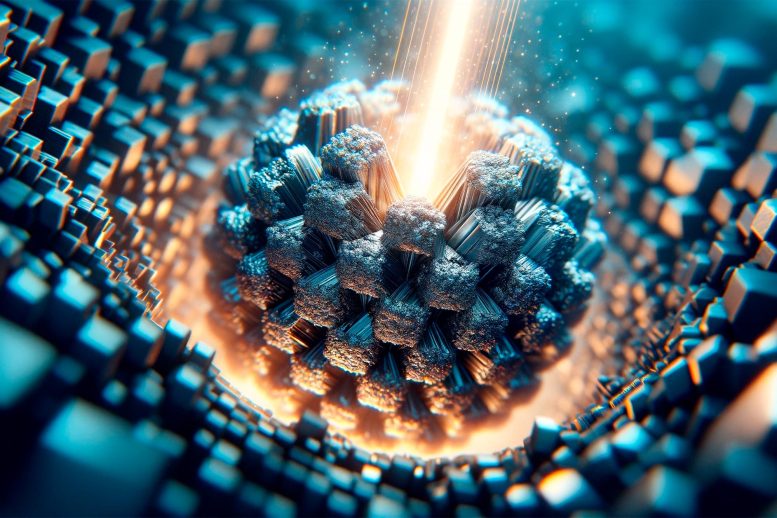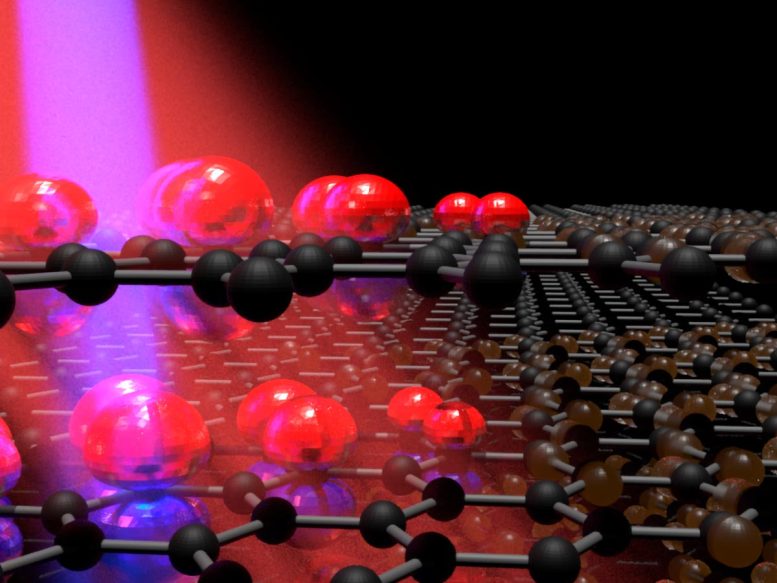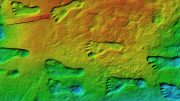
X-ray absorption spectroscopy, an essential tool in material analysis, has evolved with the advent of attosecond soft-X-ray pulses. These pulses allow simultaneous analysis of a material’s entire electronic structure, a breakthrough led by the ICFO team. A recent study demonstrated the manipulation of graphite’s conductivity through light-matter interaction, revealing potential applications in photonic circuits and optical computing. This advancement in spectroscopy opens new avenues for investigating many-body dynamics in materials, a key challenge in modern physics. Credit: SciTechDaily.com
Advancements in attosecond soft-X-ray spectroscopy by ICFO researchers have transformed material analysis, particularly in studying light-matter interactions and many-body dynamics, with promising implications for future technological applications.
X-ray absorption spectroscopy is an element-selective and electronic-state sensitive technique that is one of the most widely used analytical techniques to study the composition of materials or substances. Until recently, the method required arduous wavelength scanning and did not provide ultrafast temporal resolution to study electronic dynamics.
Over the last decade, the Attoscience and Ultrafast Optics group at ICFO le,d by ICREA Prof. at ICFO Jens Biegert h, has developed attosecond soft-X-ray absorption spectroscopy into a new analytical tool without the need for scanning and with attosecond temporal resolution.[1,2]
Breakthrough in Attosecond Soft-X-ray Spectroscopy
Attosecond soft-X-ray pulses with a duration between 23 as and 165 as and concomitant coherent soft-X-ray bandwidth from 120 to 600 eV[3] allow interrogation of the entire electronic structure of a material at once.
The combination of time resolution to detect electronic motion in real-time and the coherent bandwidth that registers where the change happens provides an entirely new and powerful tool for solid-state physics and chemistry.

Exposing graphite to an intense ultrashort mid-infrared laser pulse induces a highly conductive light-matter hybrid phase as optically excited electrons strongly couple to coherent optical phonons. The observations of such a strongly optically driven many-body state becomes possible by studying the lifetime of the excited electronic states with a attosecond soft-X-ray pulse.” Credit: ©ICFO
One of the most fundamentally important processes is the interaction of light with matter, e.g., to understand how solar energy is harvested in plants or how a solar cell converts sunlight into electricity.
An essential aspect of material science is the prospect of altering the quantum state, or the function, of a material or substance with light. Such research into the many-body dynamics of materials addresses core challenges in contemporary physics, such as what triggers any quantum phase transition or how properties of materials arise from microscopic interactions.
Recent Study by ICFO Researchers
In a recent study published in the journal Nature Communications, ICFO researchers Themis Sidiropoulos, Nicola Di Palo, Adam Summers, Stefano Severino, Maurizio Reduzzi, and Jens Biegert report on having observed a light-induced increase and control of the conductivity in graphite by manipulating the many-body state of the material.
Innovative Measurement Techniques
The researchers used carrier-envelope-phase-stable sub-2-cycle optical pulses at 1850 nm to induce the light-matter hybrid state. They probed the electronic dynamics with attosecond soft-x-ray pulses with 165 as duration at the carbon K-edge of graphite at 285 eV. The attosecond soft-X-ray absorption measurement interrogated the entire electronic structure of the material at attosecond-interval pump-probe delay steps. The pump at 1850 nm induced a high conductivity state in the material, which only exists due to the light-matter interaction; thus, it is called a light-matter hybrid.
Researchers are interested in such conditions since they are expected to lead to quantum properties of materials that do not exist otherwise in equilibrium, and these quantum states can be switched at essentially optical speeds up to many THz.
It is, however, largely unclear how the states exactly manifest inside materials. Thus, much speculation exists in recent reports on light-induced superconductivity and other topological phases. ICFO researchers used soft-Xray attosecond pulses for the first time to “look inside the material” as the light-matter state manifests.
The first author of the study, Themis Sidiropoulos, notes, “the requirement for coherent probing, attosecond time resolution and attosecond synchronization between pump-and probe is entirely novel and an essential requirement for such new investigations enabled by attosecond science.”
Electron Dynamics in Graphite
Unlike twistronics and twisted bilayer graphene, where experimentalists manipulate the samples physically to observe the changes in the electronic properties, Sidiropoulos explains that “instead of manipulating the sample, we optically excite the material with a powerful light pulse, thus exciting the electrons into high energy states and observe how these relax within the material, not only individually but as a whole system, watching the interaction between these charge carriers and the lattice itself.”
To see how the electrons in the graphite relaxed after the strong pulse of light was applied, they took the broad X-ray spectrum and observed, firstly, how each energy state relaxed individually and, secondly, how the whole electron system was excited, to observe the many-body interaction between light, carriers, and nuclei at different energy levels. By observing this system, they could see that the energy levels of all the charge carriers indicated that the material’s optical conductivity increased at a point, showing signatures or reminiscence of a superconductivity phase.
Observation of Coherent Phonons
How were they able to see this? Well, in fact, in a previous publication, they observed the behavior of coherent (not random) phonons or collective excitation of the atoms within the solid. Because graphite has an array of very strong (high energy) phonons, these can efficiently transport significant amounts of energy away from the crystal without damaging the material through mechanical vibrations of the lattice. And because these coherent phonons move back and forth, like a wave, the electrons within the solid seem to ride the wave, generating the artificial superconductivity signatures that the team observed.
Implications and Future Prospects
The results of this study show promising applications in the field of photonic integrated circuits or optical computing, using light to manipulate electrons or control and manipulate material properties with light. As Jens Biegert concludes, “many-body dynamics are at the core, and, arguably, one of the most challenging problems of contemporary physics. The results we have obtained here open a new realm of physics, offering novel ways to investigate and manipulate correlated phases of matter in real-time, which are crucial for modern technologies.”
Reference: “Enhanced optical conductivity and many-body effects in strongly-driven photo-excited semi-metallic graphite” by T. P. H. Sidiropoulos, N. Di Palo, D. E. Rivas, A. Summers, S. Severino, M. Reduzzi and J. Biegert, 16 November 2023, Nature Communications.
DOI: 10.1038/s41467-023-43191-5
Notes
- “High-flux table-top soft x-ray source driven by sub-2-cycle, CEP stable, 1.85-μm 1-kHz pulses for carbon K-edge spectroscopy” by F. Silva, S. Teichmann, M. Hemmer, S. L. Cousin, J. Biegert and B. Buades, 14 September 2014, Optics Letters.
DOI: doi:10.1364/OL.39.005383 - “Dispersive soft x-ray absorption fine-structure spectroscopy in graphite with an attosecond pulse” by Iker León, Themistoklis P. H. Sidiropoulos, Irina Pi, Dooshaye Moonshiram, Antonio Picón, Jens Biegert, Nicola Di Palo, Peter Schmidt, Seth L. Cousin, Bárbara Buades and Frank Koppens, 19 May 2018, Optica.
DOI: doi:10.1364/OPTICA.5.000502 - “Attosecond Streaking in the Water Window: A New Regime of Attosecond Pulse Characterization” by Seth L. Cousin, Nicola Di Palo, Bárbara Buades, Stephan M. Teichmann, M. Reduzzi, M. Devetta, A. Kheifets, G. Sansone and Jens Biegert, 2 November 2017, Physical Review X.
DOI: 10.1103/PhysRevX.7.041030









In theory, via the synchronization effect of spin, topological vortices can synthesize any desired substance in the universe, including human thinking.
A more inclusive participation of all physics fields of study to interpret the observation could yield the broadest findings.
Why not so many comments here? Salute Great Graphite that already gave 1 Nobel Prize! Scientists contribute with devotion, dedication and hard work. Politicians mess it all up with 1st class Airfares, 5-Star Hotels, Olympics and Horse Races etc., We just cannot beat animals in their physical and immunological abilities..Forget it. Dollars are trashed by Politicians using Social activities like years-long Political Campaigns etc., Tiny Earthworms swallow soil full of so many unknowns, digest and then defecate the left overs only. Compare to Politicians that go in reverse ! We are trodding into the year 2024. We need to keep away from political struggles and keep inventing/discoering more and more. Sky is the limit. Human Brain is not for 5-Star Hotels in place of discovering more and more !
Can they Beat Unitree’s B2 Robot at 13 miles per hour speed? Discard them into arm-pit odor land. Trump was compared online to now ! Scientists should release funds/livelihood food for Politicians and not in reverse !